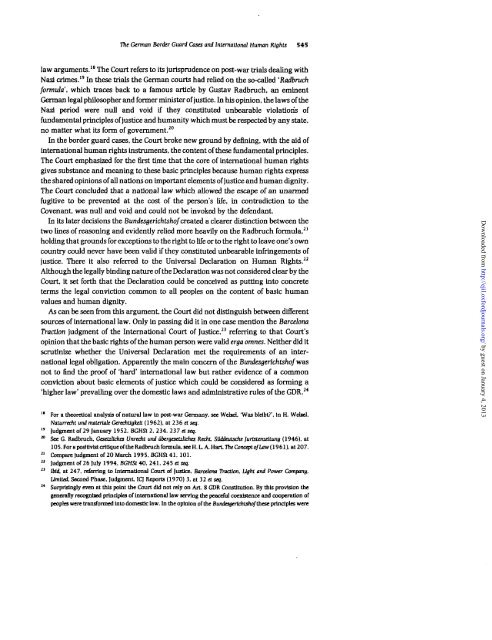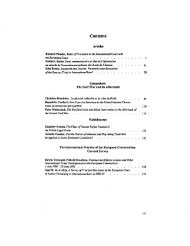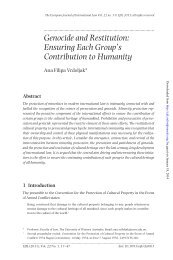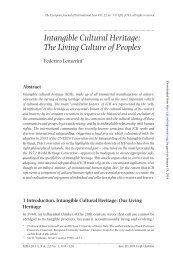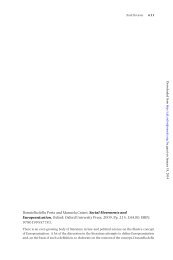The German Border Guard Cases and International Human Rights
The German Border Guard Cases and International Human Rights
The German Border Guard Cases and International Human Rights
Create successful ePaper yourself
Turn your PDF publications into a flip-book with our unique Google optimized e-Paper software.
<strong>The</strong> <strong>German</strong> <strong>Border</strong> <strong>Guard</strong> <strong>Cases</strong> <strong>and</strong> <strong>International</strong> <strong>Human</strong> <strong>Rights</strong> 545<br />
law arguments. 18 <strong>The</strong> Court refers to its Jurisprudence on post-war trials dealing with<br />
Nazi crimes. 19 In these trials the <strong>German</strong> courts had relied on the so-called 'Radbruch<br />
formula', which traces back to a famous article by Gustav Radbruch, an eminent<br />
<strong>German</strong> legal philosopher <strong>and</strong> former minister of justice, hi his opinion, the laws of the<br />
Nazi period were null <strong>and</strong> void if they constituted unbearable violations of<br />
fundamental principles of justice <strong>and</strong> humanity which must be respected by any state,<br />
no matter what its form of government. 20<br />
In the border guard cases, the Court broke new ground by defining, with the aid of<br />
international human rights instruments, the content of these fundamental principles.<br />
<strong>The</strong> Court emphasized for the first time that the core of international human rights<br />
gives substance <strong>and</strong> meaning to these basic principles because human rights express<br />
the shared opinions of all nations on Important elements of justice <strong>and</strong> human dignity.<br />
<strong>The</strong> Court concluded that a national law which allowed the escape of an unarmed<br />
fugitive to be prevented at the cost of the person's life, in contradiction to the<br />
Covenant, was null <strong>and</strong> void <strong>and</strong> could not be invoked by the defendant<br />
In its later decisions the Bundesgerichtshof created a clearer distinction between the<br />
two lines of reasoning <strong>and</strong> evidently relied more heavily on the Radbruch formula, 21<br />
holding that grounds for exceptions to the right to life or to the right to leave one's own<br />
country could never have been valid if they constituted unbearable infringements of<br />
justice. <strong>The</strong>re it also referred to the Universal Declaration on <strong>Human</strong> <strong>Rights</strong>. 22<br />
Although the legally binding nature of the Declaration was not considered clear by the<br />
Court it set forth that the Declaration could be conceived as putting into concrete<br />
terms the legal conviction common to all peoples on the content of basic human<br />
values <strong>and</strong> human dignity.<br />
As can be seen from this argument the Court did not distinguish between different<br />
sources of international law. Only in passing did it in one case mention the Barcelona<br />
Traction judgment of the <strong>International</strong> Court of Justice, 23 referring to that Court's<br />
opinion that the basic rights of the human person were valid erga omnes. Neither did it<br />
scrutinize whether the Universal Declaration met the requirements of an international<br />
legal obligation. Apparently the main concern of the Bundesgerichtshof was<br />
not to find the proof of 'hard' international law but rather evidence of a common<br />
conviction about basic elements of justice which could be considered as forming a<br />
'higher law' prevailing over the domestic laws <strong>and</strong> administrative rules of the GDR. 24<br />
For a theoretical analysis of natural law In post-war <strong>German</strong>y, see WeheL 'Was bldbt?'. In H. Webel,<br />
Natiimcht und maieriale GercchUgkdt (1962), at 236 et seq.<br />
Judgment of 29 January 1952. BGHSt 2. 234. 237 a seq.<br />
See G. Radbruch, Gtset2lichcs Unrecht und iibergeset2llches Recht, Suddeutsche Juristemeitung (1946). at<br />
105. For a poslnvist critique of the Radbruch formula, see H. L. A. Hart 77K Conceptof Law {1961), at 207.<br />
Compare Judgment of 20 March 1995. BGHSt 41. 101.<br />
Judgment of 26 July 1994. BGHSt 40, 241, 245 et stq.<br />
Brfi at 247, referring to <strong>International</strong> Court of Justice, Barcelona Traction, Light <strong>and</strong> Power Company,<br />
Limited, Second Phase, Judgment ICJ Reports (1970) 3. at 32 et stq.<br />
Surprisingly even at this point the Court did not rdy on Art 8 GDR Constitution. By this provision the<br />
generally recognhed principles of international law serving the peaceful coexistence <strong>and</strong> cooperation of<br />
peoples were transformed into domestic law. In the opinion of the Bundesgerichtshof these principles were<br />
Downloaded from<br />
http://ejil.oxfordjournals.org/<br />
by guest on January 4, 2013


